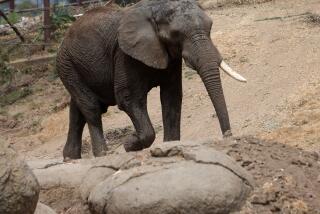Animal Attraction
- Share via
Felix, Tom, Sylvester, Stimpy, the MGM lion, the Pink Panther, Maynard G. Krebs and the late Miles Davis are just some of popular culture’s cool cats that continue to fascinate us. An entirely different species of cat, the big one, can be seen at the Shambala preserve, which is not far from beautiful downtown Acton.
As you near Shambala, located near the starting place of the Santa Clara River, the first thing you notice, besides the heat, is the healthy green canopy of mostly cottonwood and oak trees. There are also plenty of fences, because Shambala is home for nearly 70 big cats, plus a couple of African elephants, a python and a bunch of fast ducks.
After parking and a short walk, visitors register for their tour and get the chance to sign a bunch of petitions to save critters that need saving such as bears, seals and wolves.
The brains behind all this is activist-actress-conservationist Tippi Hedren, who founded Shambala in 1972, and created the nonprofit Roar Foundation in 1983. As an actor, Hedren is probably best known for her work in the famous Alfred Hitchcock thriller “The Birds” in 1962. She is also mother of actress Melanie Griffith.
The tour begins with an informal introduction by Tippi herself. Her current cause is halting the breeding and trading of wild animals, mostly predators. A tireless campaigner, Hedren has gotten measures passed in over a score of states outlawing such breeding and trading. But it is Hedren’s view that what we need is legislation with more teeth, so to speak.
“Something must be done on the federal level,” she said. “Over and over we are asked to take in animals here that are illegally bred. Over the last 25 years, it hasn’t gotten better--it’s gotten worse. It’s time to stop it. I’ve taken on one tremendous problem. Write to your congressman about the irresponsible breeding and selling of predators, and of course the worst of all, canned hunts. Your voice counts. It always counts.”
While it may be true that a Bengal tiger in the backyard will keep the burglars and the neighbor’s dog away, it is also true that wild animals make bad pets. All the critters at Shambala were born in captivity and have no survival skills and are dependent upon humans for their welfare. Animals at Shambala are never bred, sold or traded.
“They are wild animals and they were never meant to be in captivity. And those wild animal genes will never ever change. You can be their friend, but never ever trust them. Once they come here, they’re here for the rest of their lives.”
The tours, which begin close to the designated hour, are led by one of many volunteers who work at the park. Karen McClure, a four-year Shambala veteran, discussed the The Rules, which are actually quite simple: No kids under 18 are allowed at Shambala because the animals see them not as your darling Student of the Month, but more likely Meal of the Month. To a lion, a child is prey. Visitors are urged to stay away from the fence and not to crouch down, which makes you appear smaller and thus perhaps more like dinner.
The visit begins with the sleeping lion tour, but that’s not unusual. Cats sleep about 20 hours a day, and lions definitely have that part figured out. As our guide informs us that lions eat 10-15 pounds of meat per day, a lioness suddenly appears at the fence, seemingly materializing out of thin air. Lions stalk things.
Next is Hedren’s abode, where a house cat snoozes serenely on the porch. Behind the house is a large enclosure, where a cougar mugs for the camera. Next to that, a Bengal tiger ignores everyone yet keeps a diligent watch, making it clear there is no future in burglary at Shambala.
Next is the jungle cat, originally from Egypt and thought to be the ancestor of modern cats. Jungle cats have longer ears and a thicker body than house cats and a camouflage paint job. Nearby is a serval cat, which at 30 pounds, could ruin a dog’s day. These cats have no sense of style, having both spots and stripes. As the trainer wings a piece of meat at the cat, its head flattens and its ears are swept back in an F-16 mode, clearly nobody’s sweetheart.
The stars of the show and winners of the Cutest Baby Contest were a pair of tiger cubs, each 11 months old. They posed for the cameras like a couple of cover girls. The leisurely tour winds down around the cheetah cage, where the resident cat, Subira, who lost a leg to disease, still manages to do 35 mph.
Shambala survives on the largess of animal lovers, tours and an adoption program for critters that live there. Monthly adoption fees are $75 for a lion or tiger, $50 for a cougar or jaguar and $25 for a serval cat. For a cat mom or dad, visiting is allowed the first Saturday of every month.
BE THERE
Shambala preserve is located off Highway 14 at 6867 Soledad Canyon Road. The next public tours are Sat. and Sun., and July 19-20. Other arrangements may be made for group visits. Tickets are $35. Call (805) 268-0380 for reservations and information.
More to Read
Sign up for The Wild
We’ll help you find the best places to hike, bike and run, as well as the perfect silent spots for meditation and yoga.
You may occasionally receive promotional content from the Los Angeles Times.






